
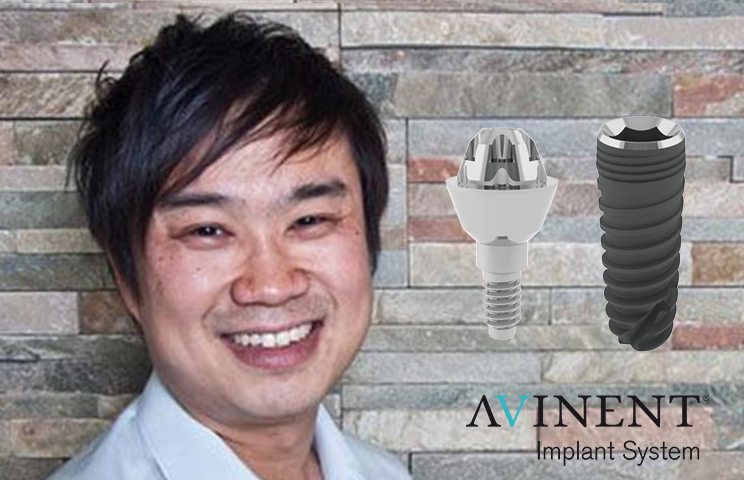
six “Hacks” to simplify the process of treating the edentulous arch with the fixed full arch implant restoration technique.
It has been many years since Dr. Paulo Malo described his innovative method of treating the fully edentulous arch1 known as all-on-four ™. The ability to slant implants and the utility of immediate loading through fixed full arch implant restorations has reduced the time, cost and invasiveness involved in treating the edentulous arch. Based on the fast-growing body of research and the sheer number of patients now successfully treated, this treatment modality has gained acceptance with most clinicians involved in implant dentistry. Developments in methods, materials and components have improved predictability, decreased treatment time and reduced costs for patients. As with any technique – even those that have been around a long time – there are new approaches that help to improve the efficacy and efficiency
Here are six “Hacks” that I have found to simplify the process of treating the edentulous arch with the fixed full arch implant restoration technique. For the purposes of clarity and consistency throughout the discussion, I have employed the AVINENT OCEAN Implant system as my example system of choice in illustrating the key points.
1. Use a moderately aggressive threaded implant
Stability of the implant has always been a key factor in placing implants in the fully edentulous arch. In many full arch cases, implants are often placed immediately into sockets and have limited bone for initial stability. Immediate loading also requires high stability of the implant in bone. Dental implants with aggressive threads and a taper help achieve desired stability in challenging conditions. Yet, implants with too aggressive a thread can be a negative factor. Edentulous arches often have a limited quantity of bone after years of edentulism. Aggressively threaded implants can break through the alveolar ridge or perforate into the sinus. Inadvertent transposing from planned osteotomies at placement is another issue. I have found that using a tapered implant design with moderately sharp threads is a good compromise to achieve the right handling properties for full arch cases.

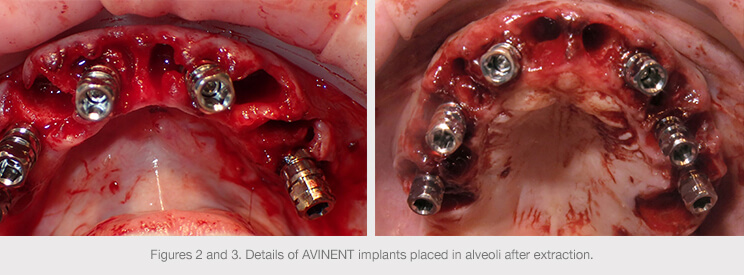
2. Employ an implant system with a variety of sizes
Full arch cases require precise placement of implants in limited quantities of bone. The aforementioned requirement for implant stability also increases the challenge with these cases. A variety of implant sizes from short and wide implants (e.g., 5X7mm to avoid the nerve and sinus) to longer ones (e.g., 15mm for maximum stability) allow the practitioner to achieve ideal positioning for the surgical and restorative requirements of full arch cases.
3. Make sure a variety of transmucosal angled abutments are available to you
Since the introduction of the All on Four ™ technique, Paulo Malo has established the success of rate of using slanted implants. The degree of angulation matched with the desired location of the access hole in the restoration can vary significantly from case to case. Having a variety of transmuscosal angled abutments (e.g., 17 degree, 24 degree and 30 degree) at a variety of heights allows for ideal positioning of the prosthetic connections. In addition, an internally hexed system also allows 6 different positions. Having fewer heights and positions can restrict your flexibility dramatically. Yet, having more makes placing abutments difficult and adds to confusion. The Avinent system has an adequate range of heights and positions that allow for maximum flexibility of abutment selection without introducing the confusion of having too many options.

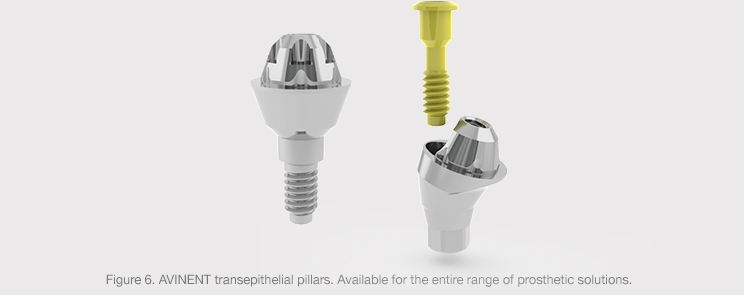
4. Choose an implant system with a single line of attachments
You will find that a variety of transmucosal abutments have to be purchased for each implant connection size. Despite the best advance planning, most full arch cases require an abundant selection of abutments before the surgery date. An implant system with a single connection size (for each diameter of implant) can reduce the cost of high value stock by multiples. In addition to lower cost, having a single connection reduces confusion for the surgeon and staff. You will find, as I did, that this is a major and important factor.
5. Place additional implants
Though Paulo Malo described his technique as “All on Four”tm, placing more than four implants is an advantage in most cases. In the upper arch, the bone is softer. Many practitioners prefer to place more implants to distribute the bite force. Another factor is the difficulty in getting stability of implants in ideal prosthetic positions. There are common scenarios where the ideal positions for the implant does not allow for adequate stability of immediate loading. These implants can still be placed and loaded after the appropriate healing time but in the meantime, additional implants be placed in other locations to achieve loading of a fixed temporary. Obviously, cost is a factor in this decision as well. Implant systems that are available at a reasonable cost (without sacrificing the other important aspects just outlined) allow more implants to be placed, giving flexibility in the treatment plan.
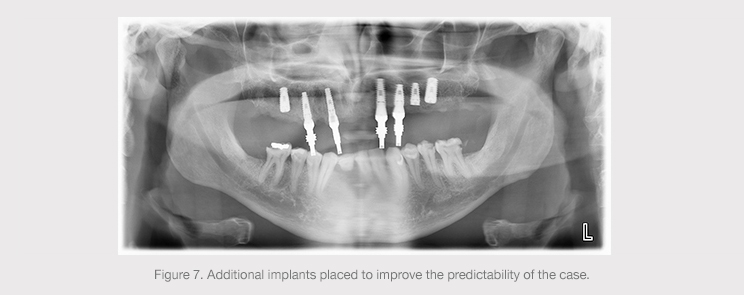
6. Use a milled temporary
Immediate loading of full arch cases has been a huge advantage. It provides relatively even force distribution over the implants versus a denture that is still very mobile despite relines. Patient acceptance is superior as the final result is much closer to natural dentition than any removable prosthesis. The largest advantage is the temporary acts as a trial run of tooth position, vertical dimension, and esthetic considerations prior to fabricating the final prosthesis.
Yet, one of the major headaches associated with immediately loading is the weakness of the converted acrylic prosthesis. Breakage is common and requires “emergency” clinic time to fix, along with causing patient dissatisfaction. The reason for the lack of strength of an acrylic fixed bridge converted from a complete denture can usually be traced to the number of different materials used in its fabrication. For example, common material choices will be the pink denture acrylic, the acrylic teeth, the composite or material used to pick up the temporary abutments and the actual temporary abutment themselves. These different materials do not necessarily bond with each other and flex at different rates. Strength can be improved with the use of lab acrylic and the help of a lab technician or denturist, but contour and material porosity is far from ideal.
A milled, lab-processed temporary solves all of these challenges. It is a one piece design created from a single material, providing superior strength, contour and polish to reduce breakage and plaque accumulation. Though a full arch milled temporary can be used on the day of surgery, it may be better to start the case with a conventional conversion from an acrylic denture and to fabricate the milled temporary after the patient is comfortable with the tooth positioning, vertical dimension of occlusion and esthetics of the initial conventional conversion. Fabricating a milled temporary is relatively easy with the lab being able to scan the chairside temporary and designing the new one as a replication.
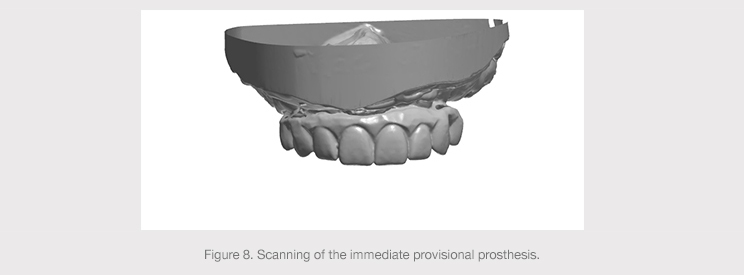

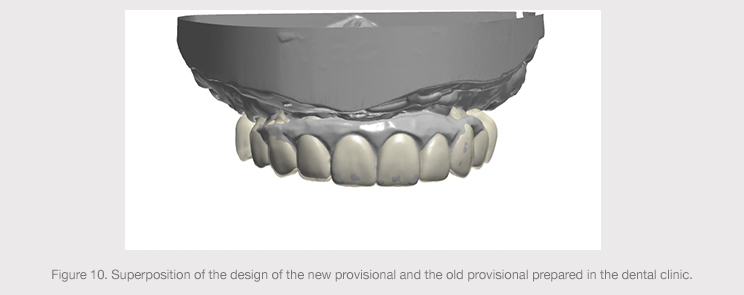

Conclusion
Treating the fully edentulous arch is full of challenges, ranging from phonetics, vertical dimension of occlusion, esthetics, function to oral hygiene. Any progress in technique and materials are welcome in making this procedure more predictable, efficient and cost-effective for our edentulous patients.
As illustrated in the two final restorative results presented in Figures 13 – 16, the biggest benefit of full arch fixed implant t restorations is the beautiful, natural esthetics available to the patient, function as close as possible to natural dentition – and the gratification available to the clinician in being able to provide them reliably and affordably.


Bibliography
1 Clin Implant Dent Relat Res. 2003;5 Suppl 1:2-9. “All-on-Four” immediate-function concept with Brånemark System implants for completely edentulous mandibles: a retrospective clinical study. Maló P, Rangert B, Nobre M.
2 Clin Implant Dent Relat Res. 2015 Oct;17 Suppl 2:e531-41. doi: 10.1111/cid.12282. Epub 2014 Dec 23. All-on-4® Treatment Concept for the Rehabilitation of the Completely Edentulous Mandible: A 7-Year Clinical and 5-Year Radiographic Retrospective Case Series with Risk Assessment for Implant Failure and Marginal Bone Level. Maló P, de Araújo Nobre M, Lopes A, Ferro A, Gravito I.